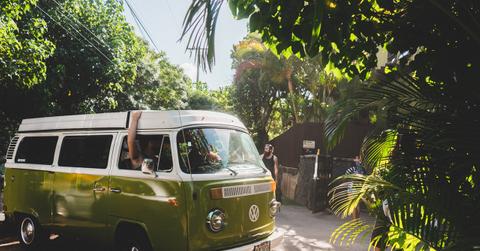Couple Transforms Old VW Bus Into Solar-Powered Vehicle
A handyman with a passion for clean energy spent two years converting a Volkswagen Bus into an electric vehicle. While it's mainly used as a camping utility for his family, it's a technical phenomenon he hopes to further evolve.
Updated May 25 2019, 6:13 p.m. ET
Solar power is the perfect complement to energizing electric vehicles. Companies like Tesla and Mercedes-Benz are attempting to tap into both sustainable markets with the addition of solar panels. One man decided to take both panels and vehicles to create an entire bus that runs off of solar energy.
Brett Belan first dove into the world of solar-powered vehicles by creating a golf cart and postal van that had solar panels attached to them. He had a passion for clean power and energy throughout his life, and he’s always been hands on with outdoor activities and craftsmanship. His wife, Kira, joined him in his quest to go off-grid.
Stepping up his game, Brett was able to find an old Volkswagen Bus to convert. One of the reasons he chose this style was due to the roof size. That gives him the ability to install four solar panels on top of the bus, and he added a mechanism for the entire wall of panels to be tilted up to a 40-degree angle. With this ability to move the vehicle, he can face the panels in any direction to get maximum energy from the sun.
In case there are weather issues, he’s got a few chargers installed that take a little over two hours to fill up the vehicle with energy. According to the details on the VW bus listed on his webpage, he can get approximately 50 miles on a full day’s charge, but that distance grows or shrinks depending on the speed he’s driving. It also depends on natural factors, like elevation levels and how the wind is blowing.
If Brett leaves the bus in his driveway without changing things up, it would take at least three days for the car to charge by itself from solar energy. While absorption is fairly inefficient, he’s working on creating a controller that does a better job. That’s part of why the vehicle is set up more as an RV and is used for quick camping trips.
Kira was the person behind the interior design. She set up the homey feel along with a table, pump sink, and a single burner for cooking. As the vehicle absorbs the sunlight, these can generally be used without pulling out too much electricity for driving. They were also able to add a small refrigerator between the two main seats that doesn’t require monitoring. Brett says that due to so little energy being pulled out, it’s always on.
A big question Brett receives about the vehicle is how top-heavy it is with the addition of four solar panels. He says in the video above that he hasn't ran into many issues. As he explains, “When you put the canvas up there, you’d have this huge sail. However, with a 1,000 pounds of lead balance near the center of the vehicle, we really haven’t seen a problem. We came through some pretty high winds on our trip and even though it’d blow the canvas around a little bit, the thing won’t budge.”
Phase two is next for Brett’s solar-powered VW bus. While the main version was to simply limit costs and get things up and running, the next step is to add awning systems and lithium ion batteries. The goal is to get a few hundred miles on a single charge.
